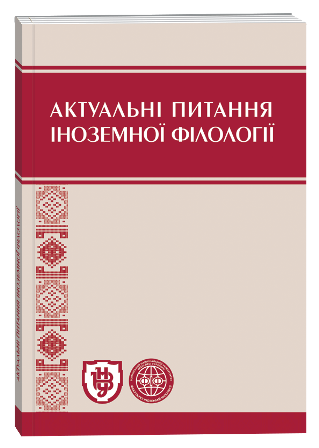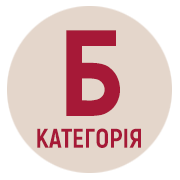IMAGE AS A BASIS FOR THE FORMATION OF PHRASEOLOGICAL MEANING
DOI:
https://doi.org/10.32782/2410-0927-2022-16-23Keywords:
image, image trait, genetics of images, internal form, phraseological meaning, phraseological semiosisAbstract
The article is devoted to the analysis of the process of phraseological semiosis on the basis of image and identification of genetic types of images that serve as the basis for the formation of the internal form of phraseological meaning. The image is considered as a unit of thought that arose as a result of knowledge of the real world. Objects, phenomena of objective reality are perceived from the standpoint of anthropocentrism, which provides their national-specific perception, vision and evaluation. Signs, characteristics, properties of a recognizable object or phenomenon are revealed, as a result of which a new image is concluded in the human consciousness. The components of a new image are already known images and ideas about an object or phenomenon – cognitive knowledge, which operates memory in the process of cognition, the result of which is a generalized and abstract from the real simplified image. The mental image does not reflect the real object, but only its main features. In order to ensure the communicative function of language, the mental image is verbalized. To choose the appropriate language form, one of the features of the image is singled out, which acts as a motivator of the nomination. To linguize the motivator, a language sign is used, which has a corresponding component in its seed set. The rest of the unused features of the image are implicitly preserved, creating certain stylistic and pragmatic potentials. We have defined national-cultural and transcultural as the basic groups of images of phraseological semiosis. Analysis of images of national and cultural origin, which served as the basis for the formation of the internal form of phrases, revealed their genetic groups associated with onyms, place names, astronomers, gastronomes, names of clothing and footwear, names of currencies, names of length, weight, volume and time, artefacts, colouronyms, zoonyms, phytonyms, folklore images. Phraseologisms to denote stereotypes formed using the sign-motivator of transcultural images, associated with mythologies, biblical studies, the names of world-famous personalities of non-German origin, non-cultural lacunas.
References
Алефиренко Н. Ф. Теоретические основы учения о «внутренней форме» фразем. Семантика языковых единиц. Москва, 1996. С. 128–130.
Алефиренко Н. Ф., Аглеев И. А. Когнитивная метафора и фраземосемиозис. Когнитивные факторы взаимодействия фразеологии со смежными дисциплинами : сб. науч. тр. по итогам III Междунар. науч. конф. (Белгород, 19–21 марта 2013 года) / отв. ред. проф. Н. Ф. Алефиренко. Белгород : ИД «Белгород» НИУ «БелГУ», 2013. С. 29–32.
Добровольский Д. О. Беседы о немецком слове. Москва : Языки славянской культуры, 2013. 752 с. URL: https://books.google.com.ua/books?id=q8 GFCgAAQBAJ&printsec=frontcover&hl=uk#v=onepage&q&f=false
Мелерович А. М. О внутренней форме фразеологизма. Вопросы семантики фразеологических единиц. (На материале русского языка). Часть 1. Тезисы докладов и сообщений. Новгород, 1971. С. 58–66.
Особливий статус корови в індуїзмі або поклоніння священній тварині. URL: https://ukranimals.ru/zdorovja/18791-osoblivij-status-korovi-v-induizmi-abo-pokloninnja.html
ПАУСФС: Практичний англо-український словник фразеологічних синонімів. A Living English-Ukrainian Dictionary of Phrasal Synonyms. Автори – укладачі: Береза Т. А., Коцюк Л. М., Кулинський О. С. URL: https://www.oa.edu.ua/ua/departments/filologist/filol_literature/dictionary
Потебня А. А. Слово и миф в народной культуре. Собр. тр. [Т. 2]. Москва : Лабиринт, 2000. 479 с.
Телия В. Н. Русская фразеология в контексте культуры: семантические, прагматические и лингвокультурологические аспекты. Москва : Языки русской культуры, 1986. 260 с.
Фреге Г. Смысл и денотат. Семиотика и информатика. Москва, 1977. № 8. С. 185.
Священна корова. Історія релігій. URL: https://tureligious.com.ua/sviashchenna-korova/11. Bargmann S., Sailer M. The syntactic flexibility of semantically non-decomposable idioms. URL: https://langsci-press.org/catalog/view/184/1006/1068-1
Burger H., Buhofer A., Sialm A. Handbuch der Phraseologie. Walter de Gruyter Berlin – New York, 1982. 420 S. URL: https://books.google.com.ua/books?id= cZRKdD-xrXgC&printsec=frontcover&hl=uk#v=onepage&q&f=false
DWDS: Der deutsche Wortschatz von 1600 bis heute. URL: https://www.dwds.de/wb/Hund
Duden. Rechtsschreibung. URL: https://www.duden.de/rechtschreibung/Hund
WRARWiASWUS: Wörterbuch für Redensarten, Redewendungen, idiomatische Ausdrücke, Sprichwörter, Umgangssprache. URL: https://www.redensarten-index.de/







